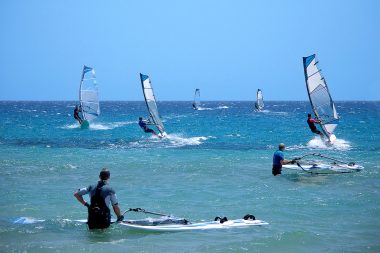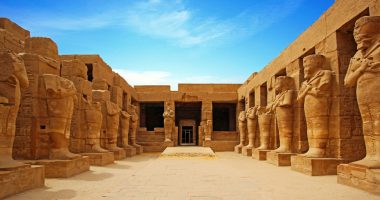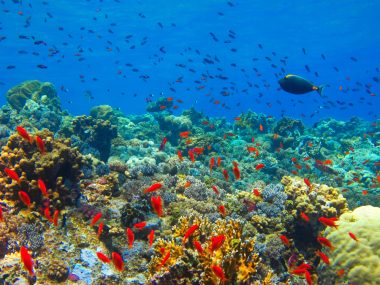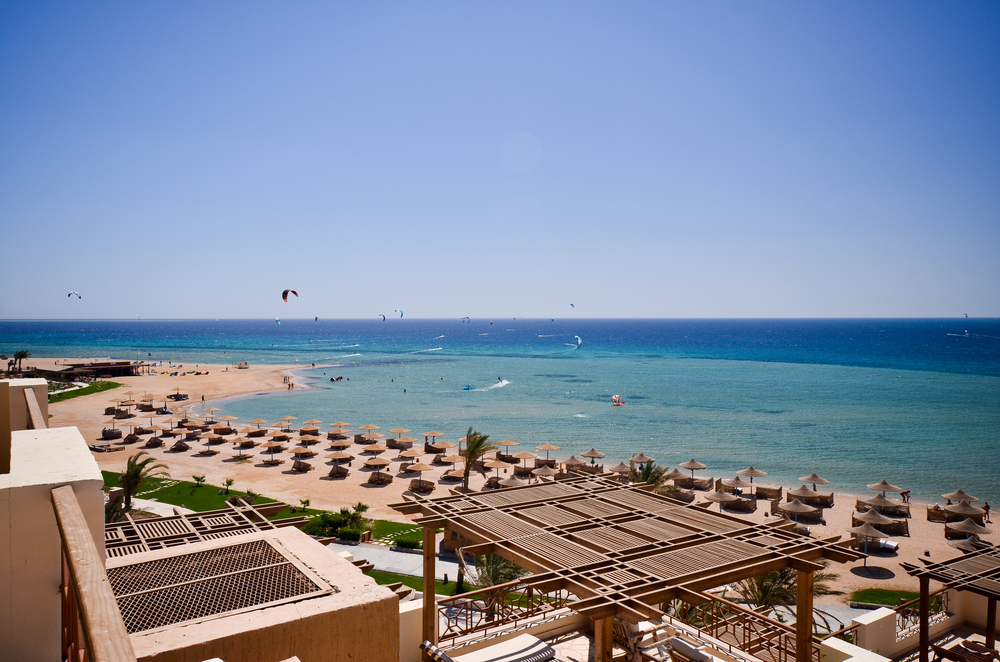53 kilometers south of Hurghada is Safaga, an old seaport known for its clean air, black sand dunes and mineral springs. Safaga is considered Egypt’s most important phosphate export center and important seaport. Many visitors also come for medical reasons. Safaga is said to have extraordinary potential for curing psoriasis, rheumatism and arthritis, but also for back problems and improving blood circulation. Due to its positive effect on the skin, Safaga has also developed into a true beauty pilgrimage site.
The clean beaches and the always stiff sea breeze make Safaga an excellent place for diving holidays. Although Safaga is an excellent destination for diving and snorkeling, the city is even more famous for its ideal conditions for kitesurfing and windsurfing. In 1993, Safaga even hosted the World Windsurfing Championships.
The city is also a perfect starting point for sightseeing tours. The desert west of the city is home to just as many historical treasures as the Red Sea, which borders Safaga to the east.
For day trips by speedboat to the wall of fire, the Forbidden Reef or the ferry wreck of Arish El Tor, it is best to book a local guide on site. In addition, there are excursions to the famous Tobia Islands, the Panorama Reef with the towering corals of Abu Qitan and the legendary Mons Claudianus, the ruins of a Roman settlement dating back to 68 AD, where granite buildings from the surrounding mountains were used exclusively for the purpose of the imperial Rome .
Beaches and water sports in Safaga
The beaches in Safaga are immaculate and beautiful. Most hotels in Safaga have their own private beaches that are exclusively available to hotel guests. Hotels and resorts in Safaga offer a wide range of water sports and activities related to the sea, from snorkeling trips to pedal boats, canoeing and catamarans.
Windsurfing in Safaga

Safaga hosted the Red Sea Windsurfing World Championships in 1993 and has an excellent reputation among windsurfing and kitesurfing. The winds in the Red Sea are caused by the temperature difference between land and water, and Safaga benefits from a generally flat coastline with no fringing reefs. This creates perfect conditions.
Safaga is therefore ideal for beginners in the field of windsurfing, but also advanced windsurfers get their money’s worth.
Ancient Egypt from Safaga

Safaga is a good starting point for inland sightseeing. Luxor is easy to reach. It is often referred to as the largest open-air museum in the world. Due to the numerous well-preserved ancient monuments in the city and its surroundings, it is the ideal destination for an exciting day trip. The city of Luxor was built on the ruins of the ancient city of Thebes and is located on the east side of the Nile. Karnak is located in the north and Thebes on the west bank. It is a “must” for any holiday in Egypt to visit the Luxor Temple built by Amenhotep III and the Karnak Temple. Luxor is also close to the Valley of the Kings and the Valley of the Queens.
Mons Claudianus is one of the best preserved sites of Roman civilization in Egypt. As a Roman penal colony and quarry, the stones worked by the prisoners were used as building material for the Roman Empire. Mons Claudianus’ gleaming black stones can still be seen today in Hadrian’s villa, in the portico of the Pantheon, in public baths, and in the columns and floor of the Temple of Venus in Rome.
Attractions in Safaga
Ferry wreck ‘El Arish El Tor’
The Norwegian ferry sank in 2002 and came to a standstill on its port side. The wreck starts at a depth of 15 meters and goes down to 38 meters. Its abundance of fish and the abundant growth of soft corals, especially on the propellers, as well as the remains of former seating areas on deck, make the wreck worthwhile for wreck divers and underwater photographers alike. Even the former utensils on board the ship, such as life jackets or fire hoses, can still be seen – none of which were needed when the ship slowly sank at anchor, because it was unmanned. This wreck is home to many yellow-tailed barracuda, Indian mackerel often hunt around them and swarm across the deck – an unforgettable natural spectacle.
Firewall
The reef offers abundant coral growth and many marine animals such as fusilier and goat fish, as well as the ubiquitous lionfish. The plateau is home to groups of smaller coral heads that are home to anemones and clownfish, as well as even the otherwise rare moray eels. Encounters with large stingrays such as feather-tailed or eagle rays are also common.
Forbidden Reef
It is a large reef accompanied by ergs. Next to the reef, the depth is 10 meters, and further out it is up to 30 meters, where the seabed is covered with bizarrely shaped coral blocks. This site is very rich in fish, especially schools of fusiliers, as well as large jacks and barracuda. Groups of dolphins also frequently visit this dive site. A dive can be done as a mooring line or as a drift dive and is suitable for all levels.
Mons Claudianus
This huge Roman site and important landmark is named after Mons Claudianus, who once supplied grey granite for the Roman Empire. One thousand stone crushers and Roman soldiers were stationed in this part of Hurghada for over two centuries. Even today, objects from Mons Claudianus can be seen in the Pantheon, Hadrian’s villa and the unfinished Temple of Venus. Other sights are the old fortress, apartments, workshops, stables, baths, granite columns and slabs.
Panorama Reef

If you want to go diving in Panorama Reef, you should plan several dives, as you will not visit this place only once. This is due to the huge plateau and rich slopes that you should not miss. The diver’s paradise is located 60-90 minutes outside of Safaga.
The reef is the largest reef in Safaga and offers arguably the largest underwater variety of plants and animals. Due to the current from the north, the reef is particularly suitable for drift diving. The North Plateau is home to many purple corals, dolphins, and gray reefs, to name a few. However, the main attraction of the reef is, of course, the steep walls, which disappear into the depths at a depth of more than 20 meters. The coral life of the reef is characterized by soft corals. The abundance of different fish species in this reef is simply gigantic. For example, there are parrotfish, lionfish, and scorpion fish, to name a few.
Tobia Island
Tobia Island, a surfer’s paradise, is a small bank island in the middle of Safaga Bay. Tobia Island is considered the perfect place to spend a day at sea on one of the many day trip dive boats. It is also a wonderful place to snorkel and observe the excellent coral heads in the shallow water, making snorkeling easy, fun, and ideal for children. For those who like it more challenging, some of the best diving in the region can be done from Topia Island. Dive boats will take you to different locations where you can experience many different types of dives in a single trip, from sandy shallows to towering coral columns.
Diving in the Red Sea off Safaga
Diving around Safaga is varied and interesting. There are fewer dive centers than in Hurghada in the north, which means that the dive sites are less crowded and the corals are in better condition. With dives on the house reefs for beginners and some deeper drift dives offshore for advanced divers, there is something for divers of all levels. The coral reefs are characterized by pinnacles, slopes, grottos, and overhangs, and are all abundantly populated with marine life. There is also the wreck of the Salem Express, a hundred-meter-long ferry that sank in December 1991 and unfortunately killed about five hundred passengers on board who wanted to make a pilgrimage to Mecca. To venture a little further afield, a liveaboard excursion might be a better option for the avid diver, as otherwise most resorts offer day dives from boats or from the shore.
But whether you’re looking for a diving adventure or the perfect wave, whether you just want to relax on the beach or explore the historical monuments of ancient Egypt, you’re guaranteed to find something for everyone on a holiday in Safaga.


